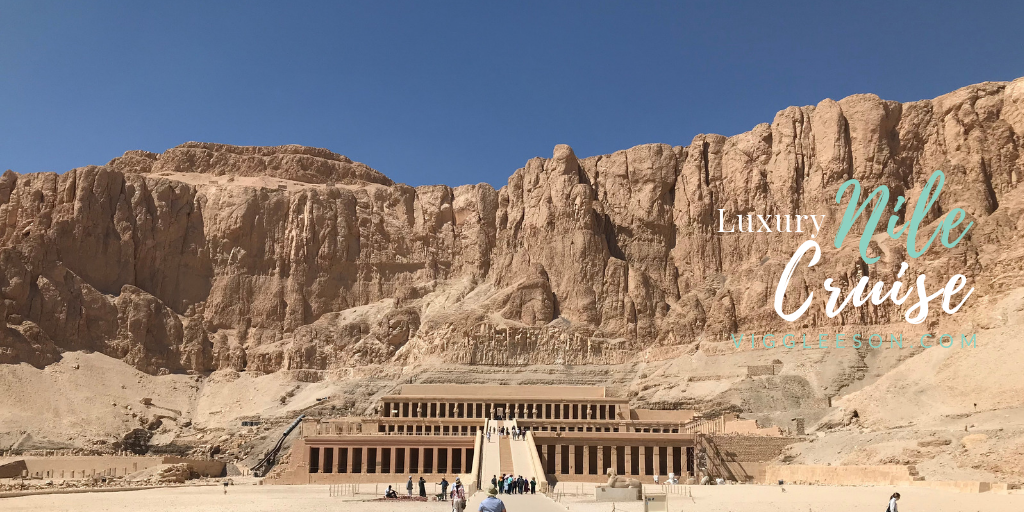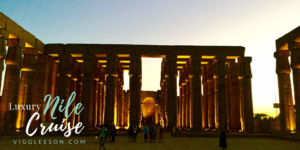Valley of the Kings
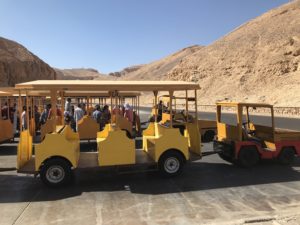 By 9 the next morning we’re chugging along on the little train that brings us to the tomb of Tutankhamun, but we don’t enter here. According to Ahmed the best place to visit King Tut is in the Museum in Cairo. With many tombs more elaborately decorate in The Valley of the Kings, we follow Ahmed’s advice and visit three of the Rameses burial sites that are open today.
By 9 the next morning we’re chugging along on the little train that brings us to the tomb of Tutankhamun, but we don’t enter here. According to Ahmed the best place to visit King Tut is in the Museum in Cairo. With many tombs more elaborately decorate in The Valley of the Kings, we follow Ahmed’s advice and visit three of the Rameses burial sites that are open today.
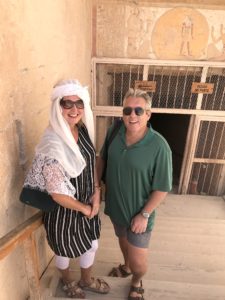 Tombs are opened and closed in rotation and tour guides are no longer allowed to lecture inside them, to help preserve the wall paintings, which vividly depict the mystery of the Pharaohs’ death rituals, in glorious colours, none of which we are lowed to photograph. Laughs are being had when one of the gatekeepers rearrange my shawl into a turban for a tip of 20 LE, some will let you bend the photography rule for 100 LE or more. My new getup is too hot on my head and by the time we emerge from the last tomb I unravel my scarf and let it hang loose again.
Tombs are opened and closed in rotation and tour guides are no longer allowed to lecture inside them, to help preserve the wall paintings, which vividly depict the mystery of the Pharaohs’ death rituals, in glorious colours, none of which we are lowed to photograph. Laughs are being had when one of the gatekeepers rearrange my shawl into a turban for a tip of 20 LE, some will let you bend the photography rule for 100 LE or more. My new getup is too hot on my head and by the time we emerge from the last tomb I unravel my scarf and let it hang loose again.
Jingling back on the train to the visitor centre we make a pee stop at the dilapidated toilets and pay a toothless old Egyptian an extortionate tip for the unpleasantness, we are out of small notes already.
https://en.wikipedia.org/wiki/Valley_of_the_Kings
‘La-la-la-la’ I swat at the air of merchants offering reams of postcards and CD’s, ‘Five pounds,’ they call after me and I wonder what currency they’re quoting. The souvenirs, Panama hats and nicknacks are the same everywhere, worthless trinkets only a child would buy.
To souvenir shop or not
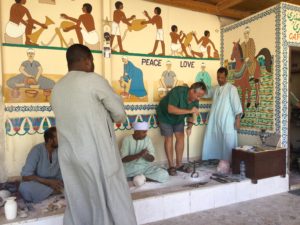 The day is hot and the drive to the Valley of the Queens too short for the air-con to kick in. Ahmed gripes about the cheap tat the vendors are hawking and want to show us the difference between fake and real alabaster. ‘No need to buy anything’ he promises as we turn off the road to a shop fronted by three men toiling over the making of ‘real’ alabaster jars, ‘just have a look.’
The day is hot and the drive to the Valley of the Queens too short for the air-con to kick in. Ahmed gripes about the cheap tat the vendors are hawking and want to show us the difference between fake and real alabaster. ‘No need to buy anything’ he promises as we turn off the road to a shop fronted by three men toiling over the making of ‘real’ alabaster jars, ‘just have a look.’
Ahmed shakes hands with a robed Egyptian who proceed to show offered tea, Egyptian coffee or soft drinks. Shane has a go at the lathe drill, it is very obvious this display is just for show. Inside the shop, shelves full of jars, vessels, lamps and ornaments line the walls from floor to ceiling. In the inner chamber Americans are haggling over, apparently original, pieces of carved rock, we turn and walk back out. I feel uncomfortably pressured by our sales guy and quickly pick out a large vase from the top shelf and a boat carved in green alabaster, they’re both lovely. The salesman wants us to continue looking but ‘Halas’ I say, ‘give us your lowest price.’ 3,500 LE for the small green vessel he quote, and we walk out the door, making sure he knows he’s offended us.
Valley of the Queens
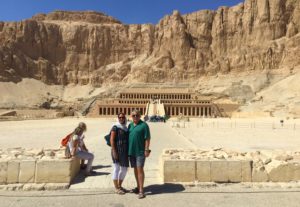 We stop in the cool of the visitor centre for a brief history lesson on the excavation of the Valley of the Queens. Hidden in a ravine on the southern end of the Theban hillside, just across the mountain from The Valley of The Kings, this ancient burial site for the wives and children of the reigning Pharaohs dates back to the 18th dynasties.
We stop in the cool of the visitor centre for a brief history lesson on the excavation of the Valley of the Queens. Hidden in a ravine on the southern end of the Theban hillside, just across the mountain from The Valley of The Kings, this ancient burial site for the wives and children of the reigning Pharaohs dates back to the 18th dynasties.
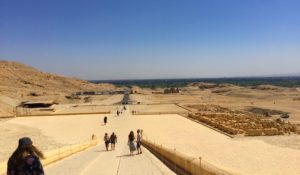 As we walk the long promenade up to Queen Hatshepsut’s Palace, Ahmed tells us the story of the 58 tourists and four Egyptians who were massacred here in 1997, by Islamist militants. I send up a prayer for the victims and their families and for Egypt to continue to grow more stable as her history continues through centuries to come.
As we walk the long promenade up to Queen Hatshepsut’s Palace, Ahmed tells us the story of the 58 tourists and four Egyptians who were massacred here in 1997, by Islamist militants. I send up a prayer for the victims and their families and for Egypt to continue to grow more stable as her history continues through centuries to come.
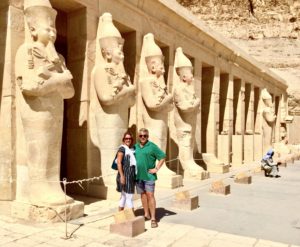
We stop for photos in front of the massive statues of Queen Hatshepsut that guards the entrance to her funerary monument. Last night, Ruby’s teachers posted photos of them all at this very spot.
The details of how Hatshepsut transition from Queen to Pharaoh, is not fully revealed, but the 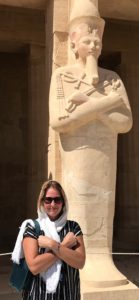 speculations are fascinating tales of intrigue, trickery and determination some 3,500 years ago. 14 centuries before Cleopatra, Hatshepsut went on to become one of Egypt’s most successful pharaohs, her reign lasting 22 years. Unlike other rulers in the dynasty, her priority laid in securing economic advancement, rather than conquering new lands. A woman of my own heart.
speculations are fascinating tales of intrigue, trickery and determination some 3,500 years ago. 14 centuries before Cleopatra, Hatshepsut went on to become one of Egypt’s most successful pharaohs, her reign lasting 22 years. Unlike other rulers in the dynasty, her priority laid in securing economic advancement, rather than conquering new lands. A woman of my own heart.
Some weeks later I visit the Sun Ship at the Pyramids of Giza, a masterpiece in craft and marinemanship, – impossible for the mind to phantom it was built 4,500 years ago. Did Hatshepsut influence the building of this and other ships like it? Apparently, she killed the famous architect who constructed her tomb, to prevent him from building new structures more refined than hers. What was up with that?
I wander along her courtyards and columns, chambers and statues in silent awe and wonderment. Who were you Hatshepsut? What was your power about? How did your story unfold?
https://www.youtube.com/watch?v=sybYa6gNhpE
https://en.wikipedia.org/wiki/Valley_of_the_Queens
https://www.osiristours.com/who-was-queen-hatshepsut/
Colossi of Memnon
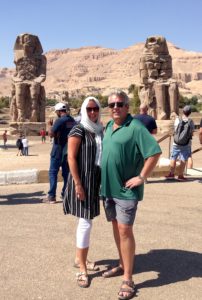 Our last stop on our morning excursion is for the two gigantic statues at Colossi of Memnon. To me, the name can only mean colossal monuments, but I’m wrong. Memnon, whose name means the Steadfast or Resolute was said to be the son of Eos, the goddess of dawn, and colossi, as I should know, means a statue much larger than life-size. Representing Pharaoh Amenhotep III, the two statues rise 18m from the desert floor and are each cut from a single piece of stone, but how did the stones get here? Rumours have it that the two blocks of quartzite sandstone were quarried near Cairo, and, transported 675 km overland to Thebes, but how was that even possible some 4,000 years ago? My brain just isn’t flexible enough to bend around such ideas.
Our last stop on our morning excursion is for the two gigantic statues at Colossi of Memnon. To me, the name can only mean colossal monuments, but I’m wrong. Memnon, whose name means the Steadfast or Resolute was said to be the son of Eos, the goddess of dawn, and colossi, as I should know, means a statue much larger than life-size. Representing Pharaoh Amenhotep III, the two statues rise 18m from the desert floor and are each cut from a single piece of stone, but how did the stones get here? Rumours have it that the two blocks of quartzite sandstone were quarried near Cairo, and, transported 675 km overland to Thebes, but how was that even possible some 4,000 years ago? My brain just isn’t flexible enough to bend around such ideas.
By now Shane is eager to get back to Amwaj and I do a quick Facebook Live from the plateau, by the souvenir shops, where the driver had parked our private bus. I’m not looking forward to the long drive back and I’m very pleasantly surprised when we’re dropped, 5 minutes down the road, at a ferry dock for a short crossing back to the East Bank.
We dock right beside M/S Amwaj, whose crew is readying the dining room for lunch.
Next : Temples of Karnak and Luxor – Continue reading
Gina is doing her Egyptian Luxury Tour in November 2018. Visit Egypt Luxury Tour on Facebook to book and find out more.
Much Love and Light
Vig ❤️
I’d love to keep in touch, don’t you? Pop your details in below and every few weeks, or so, I’ll send you my musings on writing, life and #TRUTH.
[yikes-mailchimp form=”1″]
